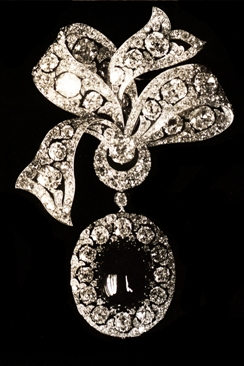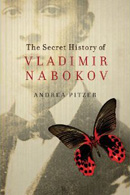The missing crown jewels
In Vladimir Nabokov’s 1962 novel Pale Fire, hidden crown jewels haunt the narrator, Charles Kinbote. The mad, self-absorbed Kinbote believes himself to be the exiled king of Zembla, a northern ruler overthrown by a Soviet-style neighbor. Throughout the book, Kinbote references agents searching the Zemblan castle for missing jewels, but the treasures never turn up, and Kinbote is sure they are so well hidden they never will be found.
 A half-century later, readers and critics are still arguing over the meaning and importance of Pale Fire‘s crown jewels. Are they the key to a secret understanding of the novel, or a red herring to baffle literalists who would strip the book of its magic? Nabokov himself encouraged (or taunted) the literalists—years after the book’s publication, he was still dropping hints about the location of the missing gems.
A half-century later, readers and critics are still arguing over the meaning and importance of Pale Fire‘s crown jewels. Are they the key to a secret understanding of the novel, or a red herring to baffle literalists who would strip the book of its magic? Nabokov himself encouraged (or taunted) the literalists—years after the book’s publication, he was still dropping hints about the location of the missing gems.
Exploring the fate of those jewels in detail, The Secret History of Vladimir Nabokov offers a solution to their mystery. But only recently did I learn from the U.S. Geological Survey that the real-world Russian crown jewels, with their own mysterious past, have begun to pose new riddles, too.
In writing about crown jewels, the Russian-born Nabokov was not operating in a historical vacuum; he was playing off the attraction and fame of Imperial treasure. The Russian crown jewels were an extraordinary assortment of royal wealth at its most ostentatious. Formally organized under Peter the Great in the 18th century, the collection belonged to the Empire itself, with each subsequent ruler adding to the national trove, which was eventually housed in the Diamond Room of the Winter Palace in St. Petersburg.
Just how difficult it is to separate the power, beauty, and wealth bound up in the gems is apparent in this 1839 description* of a visit to the Diamond Room:
Diamonds, rubies, and emeralds are arranged round the room in small cases, of such dazzling beauty that it is almost bewildering to look at them . . . The crown of the emperour is adorned with a chaplet of oak leaves made of diamonds of an extraordinary size, and the imperial sceptre contains one supposed to be the largest in the world, being the celebrated stone purchased by the Empress Catharine [sic] II from a Greek slave for four hundred and fifty thousand rubles and a large pension for life.
After the Revolution, much to the consternation of Bolshevik authorities, stories proliferated about jewels smuggled out of Russia. They represented not just hidden wealth or a metaphor for the excess and privilege of the community into which Nabokov had been born—they became political symbols of everything taken from the people under the Tsars.
The symbolism played out even with less famous jewels. Privately held gems became simultaneously the sign of a class unwilling to surrender its treasures to starving citizens in the new political system and a portent of the brutality the Bolsheviks would unleash in the drive to reshape Russian society. The hunt for hidden jewels became part of Revolutionary culture and legend, with at least one commission formed to find hidden Imperial riches, and stories leaking out from Russia about the use of torture as a tool to locate concealed treasure. (See, for example, this PDF of a 1922 story from The New York Times.) The quest for jewels, and crown jewels in particular, was just as much an obsession in post-Revolutionary Russia as it would become decades later in Nabokov’s fiction.
In the wake of the Russian Civil War and just before the formation of the Soviet Union at the end of 1922, plans were made for public displays that would allow Soviet citizens and foreign visitors to see their patrimony. The jewels were fully documented, and three years later, the book Russia’s Treasure of Diamonds and Precious Stones was published, which to date has been the definitive archive of Romanov jewels.
But the U.S. Geological Survey recently discovered pictures of real-life missing crown jewels in its archives. A 1922 album owned by George Kunz, an employee of Tiffany and Co., depicts the Imperial collection and includes photos of four pieces not included in the published book and not formerly known to have been part of the trove. A post on the USGS site details the discoveries: “a sapphire and diamond tiara, a sapphire bracelet, an emerald necklace, and a sapphire brooch in the shape of a bow.”
Like the winking cross-references in Pale Fire and other Nabokov stories, the mystery of the historical crown jewels continues to play out today. USGS librarians are working with experts from around the globe to solve the riddle of the newly-unearthed pictures and their missing real-world corollaries. But so far, only one of the four “new” crown jewels—the sapphire brooch pictured here—has been traced to its 1927 sale in London. The whereabouts of the other items are unknown.
———
[For more on Nabokov’s literary interest in his own family’s jewels, which served as playthings for him in turn-of-the-century Russia and later financed part of his college education, read his autobiography Speak, Memory, and note the use of jewel-related entries in the Index, which parallel the circular take on the same theme in Pale Fire‘s Index.]
*The Diamond Room was visited by the author of this description before the 1837 fire that destroyed the interior of the Winter Palace, but his account was not published until after the blaze.
Photo credit: U.S. Geological Survey/from the collection of George Kunz

There are 2 Comments to "The missing crown jewels"
Can only wonder what VN would have made of these missing crown jewels absenting themselves from the Bolshevik hoard and turning up for sale in 1927…
There’s certainly at least a short story in there somewhere, Damien. But it might not have a happy ending…